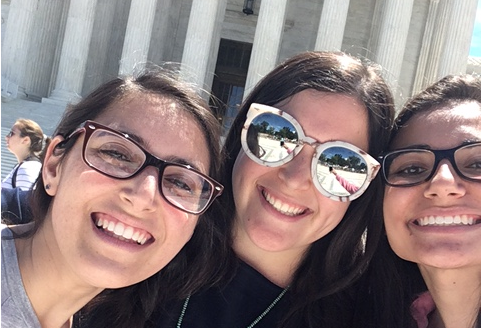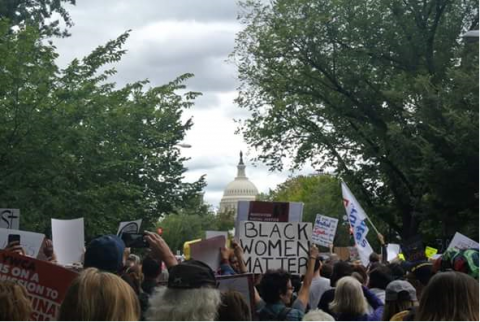On the Steps of the Supreme Court

By Chloe Bakst, NCJW Legislative Intern (pictured middle)
As nine justices revealed their latest interpretations of the “Law of the Land,” I stood right outside on the US Supreme Court steps, huddled with my friends and constantly refreshing the SCOTUSblog’s live updates. Many of my colleagues camped out all night in order to get seats inside the courtroom, and I’ve been told stories of Ruth Bader Ginsburg’s (better known as RBG!) pearl jabot and Sonia Sotomayor’s fiery dissent. Although I didn’t arrive at the court at 1:00am like the others, I still felt the excitement of being a part of this pivotal moment in American politics and law: the final session of the Supreme Court’s 2016-2017 term. The energy outside was dramatically different than it had been in previous years; there was no Whole Women’s Health v. Hellerstedt or Obergefell v. Hodges to inspire joy or outrage by those gathered on the steps, but the quieter atmosphere did not bother me. In my mind the smaller crowd made me feel even more like a D.C. “insider,” which from an intern’s perspective is always a thrill. One by one, certs (petitions to the court to hear a case) and decisions were released, and media interns dashed from the building in their sneakers and dress clothes to deliver the papers to their outlets. Meanwhile, I looked at updates from my phone and tried to decipher the differences in post-conviction rights in appellate and trial courts as determined by Davila v. Davis.
Although some of the decisions read today should have come with a Google translate button, it was fairly obvious which was the most highly anticipated: Trinity Lutheran Church v. Comer, the core of which questioned the separation of religion and state by considering whether Missouri had the right to deny the church from applying for a state grant to help pay for its public playground. The only “protesters” at the court today were a group of eight or so women and their children supporting the church. Upon hearing the decision of the court, which held that Trinity Lutheran has the right to compete with secular institutions for public grants, they began chanting “fair play won the day!” in celebration. This decision piqued my interest for a different reason, however. Although the opinion was joined by the well-known conservative Justices Thomas and Alito, Justice Elena Kagan also voted that the church had a right to receive state funds. As a Jewish woman myself, I found it strange that Justice Kagan, who has been open about her identity as a Jewish woman, would weaken the separation of religion and state. Although the decision included a footnote to clarify that it applies only to seesaws and swingsets, it seems as though the decision helped chip away at the wall between religion and state; a wall that I believe has helped religious minorities more than it has hurt religious majorities. My definition of “fair play” seems to be different from that of the women with their signs and slogans.
While working for the National Council of Jewish Women, I have been given the opportunity to engage with the legislative and judicial branches of government in exciting ways. I’ve attended Senate Judiciary hearings and lobbied my Congressman; I’ve summarized SCOTUS decisions and written action alerts. Standing on the steps of the Supreme Court today, giddily watching the world react to each decision, I was the most inspired when the justices announced the cases they will hear during the 2017-2018 term. These cases address issues like the constitutionality of Trump’s travel ban, and whether or not private businesses can deny LGBTQ individuals service. The decisions of the court on these cases will be hugely impactful and important, and I realized that although my summer in D.C. is quickly coming to an end, my passion for advocacy and its intersection with law and social justice is deeply rooted and only just beginning. I hope to be back on the Supreme Court steps next year when these opinions are read, once again a part of something greater than myself — a part of democracy at work.

